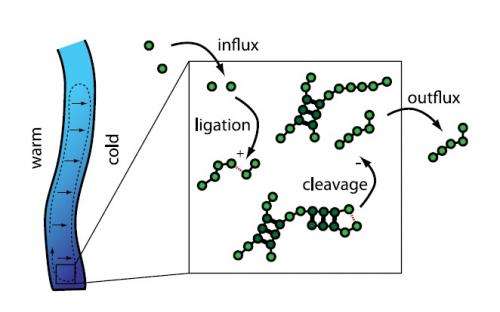July 11, 2011 feature
RNA reactor could have served as a precursor of life

(PhysOrg.com) -- Nobody knows quite how life originated on Earth, but most scientists agree that living cells did not abruptly appear from nonliving cells in a single step. Instead, there were probably a series of pre-cellular life forms that arose from nonliving chemicals and eventually led to a living cell, one that could undergo metabolism and reproduce. One of the most well-known theories of pre-cellular life is the RNA world theory, which proposes that life based on RNA predates current life, which is based on DNA, RNA, and proteins. But recently, scientists have been wondering what may have preceded RNA. In a new study, a team of scientists from Germany has suggested that the ability to self-replicate may have first emerged in the form of an RNA reactor, which they show can transmit information.
The scientists, Benedikt Obermayer, Hubert Krammer, Dieter Braun, and Ulrich Gerland of the Ludwig Maximilians University of Munich, have published their study on the prebiotic RNA reactor in a recent issue of Physical Review Letters.
The biggest piece of support for RNA molecules as pre-life forms is that RNA can act as both genes (to store information) and enzymes (to catalyze chemical reactions). Like DNA, RNA is made up of a long chain of nucleotides. However, scientists do not know how a self-replicating RNA system could have arisen from a pool of random polynucleotides.
To address this question, Obermayer, et al., have turned to RNA replicators. As described in previous research, RNA replicators can transmit information from one molecule to another so that the information survives even when the original carrier molecules have become degraded. Here, the researchers have investigated how RNA replicators may have arisen from simpler RNA reactors billions of years ago.
“We show that a combination of simple physico-chemical mechanisms can greatly facilitate the spontaneous emergence of a prebiotic evolutionary system, such as envisaged by the RNA world,” Gerland told PhysOrg.com.
Using computer simulations, the scientists analyzed a scenario in which a hydrothermal RNA reactor emerges with the ability to perform intermolecular information transmission. The scene begins inside porous rocks on the sea floor, where strong temperature gradients produce thermal convection, and the convective flow transports molecules inside the narrow pores. Due to temperature variations, nucleotides in the pores accumulate in a small region and randomly form bonds with one another. Through folding and hybridization, the polynucleotides can form longer sequences, eventually resulting in RNA strands.
One of the key factors that allows the formation of RNA strands is the preferential cleavage (splitting) of bonds at unpaired bases. This effect creates a selection pressure for base pairing, and leads to an increase in the complexity and lifetime of RNA structures. One such structure that could emerge as a result is a primitive ribozyme – or “RNA enzyme” – which can catalyze chemical reactions as a component of a true RNA replicator.
Most importantly, the computer simulations showed that the RNA reactor can perform weak replication based on information transmission by hybridization of the RNA strands. As the researchers explained, evidence of information transmission appears as an unexpected increase in the lifetime of certain sequences.
“Hybridization simultaneously protects a sequence motif and its complement from degradation,” Gerland explained. “Thereby, it extends not only the lifetime of the sequence motif, but also the lifetime of its complement, which in turn can protect other copies of the sequence motif after dissociation. This constitutes a form of information transmission between molecules, since it can conserve the information in the sequence motif beyond the lifetime of a single molecule.”
Overall, the computer simulations showed that the prebiotic RNA reactor could serve as a stepping stone toward the emergence of a true RNA replicator. Acting as a filter to keep potentially useful sequences of nucleotides, the RNA reactor could lead to complex sequences, such as ribozymes. Once ribozymes emerge from an RNA reactor, they could establish an efficient self-replicating system in the form of an RNA replicator. In the future, the researchers hope that they might be able to experimentally demonstrate such a process.
“The experimental investigation of this scenario is indeed a very exciting direction to explore,” Gerland said. “We believe it is possible to realize essential aspects of the scenario in the lab, on a small scale. We are working towards that end.”
More information: Benedikt Obermayer, et al. “Emergence of Information Transmission in a Prebiotic RNA Reactor.” Physical Review Letters 107, 018101 (2011) DOI: 10.1103/PhysRevLett.107.018101
Copyright 2011 PhysOrg.com.
All rights reserved. This material may not be published, broadcast, rewritten or redistributed in whole or part without the express written permission of PhysOrg.com.


















